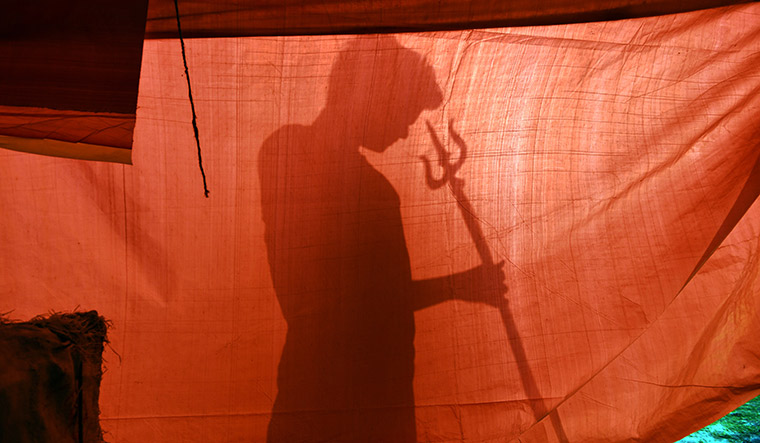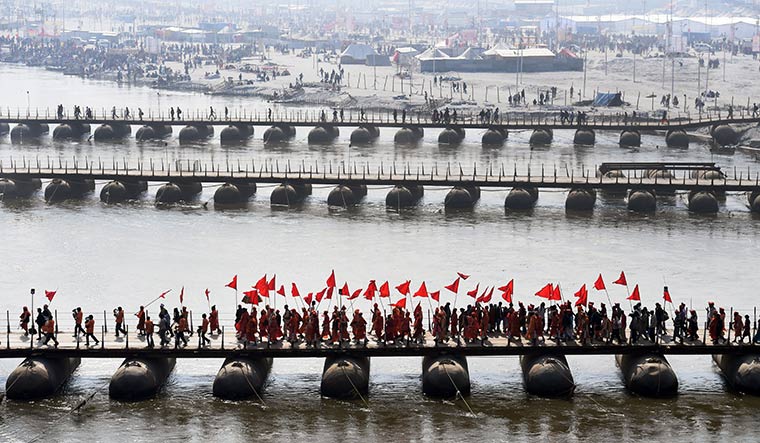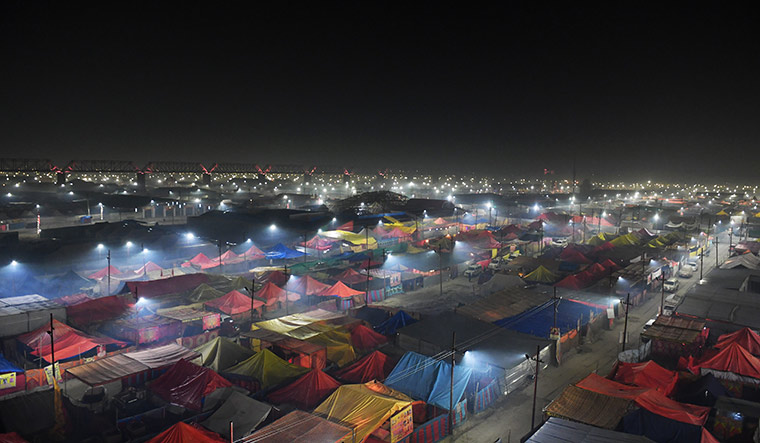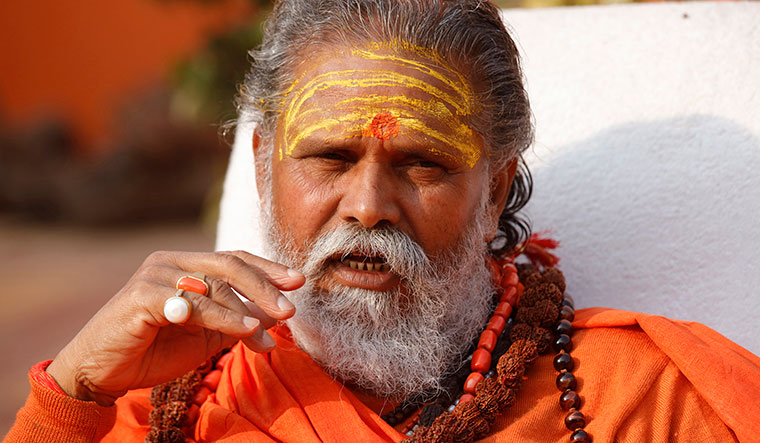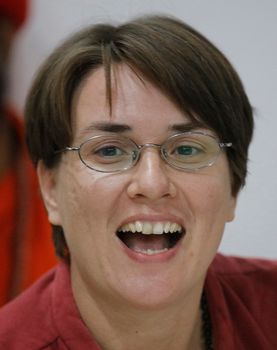Prayagraj has become a city in mystical motion. It began swaying to rhythmic drumbeats and vigorous chants early this month as waves upon waves of saffron-clad sages and ash-smeared naga sadhus arrived with ardent devotees for the Ardh Kumbh Mela at the Sangam. The formal arrival of the members of 13 akharas (schools of religious practice) was a sight to behold. They came chanting and smoking chillums, some striding in, some riding decorated horses or elephants, some rocking in magnificent palanquins and some throbbing in incongruous SUVs. It was an inclusive affair, with the Kinnar Akhara of transgenders being allowed to participate in the processions, called Peshwai, for the first time. The Kinnars sashayed in and later merged their akhara into the Juna Akhara.
Many of the pilgrims had marched for miles to reach the Kumbh Nagri at the Sangam—the confluence of the Ganga, the Yamuna and the mythical Saraswati—listening to motivational songs such as ‘Nadiya chale chale re dhara... tujhko chalna hoga (As the river flows on and on, so will you have to walk)’. Said to be the largest gathering of pilgrims, the Kumbh Mela had assumed a higher profile this time. For one, the monk who rules Uttar Pradesh, Chief Minister Yogi Adityanath, had elevated the Ardh (half) Kumbh Mela to Kumbh Mela in an audacious announcement he had made more than a year ago. Global interest in the festival had also increased after UNESCO in 2017 recognised the Kumbh Mela as an Intangible Cultural Heritage of Humanity.
But the hordes that descended on the city were impelled more by fervent faith than by the burnished image of the festival. “Jo kumbh mein naha gaya woh moksha pa gaya (One who bathes at the Kumbh attains salvation),” said the naked baba Gopal Puri, whose raised hand and overgrown, twisted nails demand your attention. He took a vow at the Kumbh Mela in Ujjain in 2016 not to lower his hand until all the sins and sorrows of India were wiped out. Absolution for sins comes easy for another baba, Swami Raghavendra, who puffed out his philosophy: “Lage dum, mite gum, yeh hai Kumbh (Smoke chillum, mitigate sorrow, this is Kumbh).” Others like Swami Bharanand get their high from the mere act of participating in the Kumbh. “Ganga maiya me jab tak paani rahe, Kumbh teri kahani rahe (As long as there is water in Mother Ganga, the story of the Kumbh will remain),” he said. Sacred chants, chiming bells and devotional songs at the Sangam create an ethereal world where the natural meets the supernatural.
So they arrived, in astounding numbers, on Makar Sankranti (winter solstice), the day the festival began—the administration said 20 million pilgrims took a holy dip at the Sangam on January 15. The days will now be longer with the sun moving into Capricorn, and politically hotter, too, with the monk’s government sparing no efforts to make it the grandest of all Kumbh Melas in modern times.
Something for even the gods to savour, perhaps. The gods and demons had churned an ocean of milk, got a kumbh (pot) of the nectar of immortality, quarrelled over its possession and, in an ensuing chase, spilled a few drops of nectar in the Ganga in Haridwar, the Shipra in Ujjain, the Godavari in Nashik and in the Sangam. The chase lasted 12 divine days—one divine day equals a year on earth—and the Kumbh Mela is, therefore, celebrated at each of the four places once in 12 years, with the venue depending on the alignment of the sun, the moon and Jupiter. A dip in these river sites during the Kumbh Mela, believe devotees, absolves all sins.
The year 2019 will see a political churning, too, as Lok Sabha elections are at hand, and the BJP governments at the Centre and in Uttar Pradesh have pulled out all the stops in organising the Kumbh Mela. Prime Minister Narendra Modi had visited the city ahead of the festival to take stock of the situation; Yogi made six visits last year. With nearly 15 crore pilgrims expected to attend the festival, the BJP hopes the Kumbh Mela will help consolidate Hindu votes ahead of the polls.
Though BJP leaders refrained from admitting it, it was clear since last May that the Yogi government would milk the festival for political nectar. In a visit to the Sangam in May, he did something that no other chief minister had done, by announcing the dates for shahi snan (royal baths) of the Kumbh Mela—January 15 (Makar Sankranti), February 4 (Mauni Amavasya) and February 10 (Basant Panchami). He also announced an innovation: helicopters would shower petals of flowers on bathing pilgrims, especially the sadhus from the akharas who take the first dip at the Sangam. In yet another departure from the secular past, the chief minister hoisted the dharam dhwaja (religious flag) of the akharas, which symbolised the formal beginning of the Kumbh.
Sins and sorrows may not be easy to erase, but names have far less adhesive properties. The name Allahabad is slowly vanishing, a cabinet meeting last October having renamed the city as Prayagraj. The revival of the city’s ancient, perhaps mythological, name has been delightful to the monks and priests and those leaning towards hindutva. They were also gladdened that the government has thrown open the temple of Akshay Vat (a banyan tree that grants wishes), which stands within Allahabad Fort.
The government has gone the whole hog to promote the Kumbh Mela, with a newly made logo for the festival. Additional Chief Secretary Awanish Awasthi, who heads the state tourism development corporation, said all official letters bore the logo, which shows seers taking a holy dip at Sangam with temples in the backdrop. Cinema theatres have been showing the logo at the end of the national anthem to popularise it.
The BJP has hopped on to the Kumbh brand wagon, featuring the word Kumbh in the names of several of its programmes. One of them, the ‘Samrasta Kumbh’, was held in Ayodhya last month to mobilise dalits and other weaker sections. Inaugurating it, Yogi said it was dalit sages who had composed most of the vedic mantras, so it was unfair that dalits had been prevented from learning the vedas. Another programme, held in Lucknow University, was called ‘Yuva Kumbh’. Here, the chief minister spoke about youth development programmes. As a political alliance against the BJP was taking shape, party strategists were emphasising ‘samagra hindutva’ (holistic hindutva) to unite the Hindu society.
The RSS, too, is using the Kumbh brand name. It is organising Netra Kumbh in Prayagraj, distributing spectacles to one lakh patients. “Our volunteers will be deployed at key points to help and guide pilgrims in various ways and we will be working with the mela administration,” said Anurag, who is the RSS zilla pracharak of Varanasi. “The RSS is essentially a Hindu organisation and only Hindus come to the Kumbh. So, if we are spreading hindutva, what is wrong with that,” he asked. “But, it is wrong to say that we are trying to mobilise Hindu votes through the Kumbh.”
The opposition parties, however, think otherwise. Joe Anthony, national general secretary of the Samajwadi Party, said, “The BJP has a habit of politicising everything. They used surgical strike and demonetisation for their political advantage. Then, why not Kumbh? But it will not benefit them. In Akhilesh Yadav’s regime, too, the Kumbh Mela was hailed by everybody. Even Harvard University constituted a team to study the Kumbh’s management.”
The Congress, too, thinks that the BJP is using the Kumbh for political advantage. “They changed the name of Ardh Kumbh to Kumbh, and Allahabad to Prayagraj. This is to placate their vote bank,” said Congress secretary B.P. Singh. “They are playing with religion and faith.” Yashwant Singh, Congress spokesperson in Uttar Pradesh, said the saffron party was trying to gain political mileage, not just from the Kumbh but also from Hindu rituals and symbols. “They have not even spared Lord Ram and Ayodhya,” he said. A Bahujan Samaj Party leader said that there was no doubt that the BJP was giving mammoth publicity to Kumbh keeping the 2019 elections in mind.
But, members of the akharas are impressed by the government’s efforts. Mahant Narendra Giri, head of the All India Akhara Parishad, was all praise for Yogi. “I give full credit to the chief minister for making the Kumbh an extraordinary extravaganza,” he told THE WEEK. “Traditions remain the same, but arrangements change with governments. This time, the government has done laudable arrangements to make it a success. There is a good deal of publicity by the government. This is for the first time that a chief minister has announced the dates for the royal baths in the Kumbh, and the seer community is fully convinced that the Kumbh, under Yogi, will be a historic event.”
To this end, the state has stayed true to its official slogan—Divya Kumbh, Bhavya Kumbh (Divine Kumbh, Grand Kumbh). It has constituted a new organisation for the Kumbh—Prayagraj Mela Pradhikaran—headed by IAS officer Vijay Anand. The Kumbh Nagri is spread across 3,200 hectares, almost double the area (1,936 hectares) for the festival in 2013. The budget is more than triple this time. While the Akhilesh Yadav government spent Rs1,214 crore for the festival in 2013, Yogi has allotted Rs4,200 crore. While most of the funds have been spent on beautification, widening of roads and expansion of parking lots, Rs116 crore was set apart for cleanliness and sanitation.
Cleanliness, in fact, ranked high among the government’s priorities. In October, it launched the Swachh Kumbh Champ Campaign to directly involve people in the cleanup drive for the Kumbh Mela. As per the official website, more than a lakh toilets were built, and 20,000 plus dustbins with liner bags placed. The government has provided 40 compactors and 120 trucks for disposal of waste. More than 15,000 sanitation workers have been posted to keep the festival grounds clean. The government said it would ensure that no effluents were discharged into the rivers. The tanneries and industrial units in Kanpur have been asked to cut down their production by 50 per cent to reduce pollution in the Ganga. “Kumbh 2019 in Prayag will be the greatest religious congregation on this earth,” said Yogi, “and I assure you that, during the Kumbh, purest water will flow in the Ganga for pilgrims and devotees. There will be no discharge of effluents into the river. This event will help in enhancing the image of the country in the eyes of the whole world.”
As part of the Kumbh, the government has renovated most of the dilapidated and neglected temples in the city. It also launched a ‘Paint My City’ campaign, which has produced paintings of folklore and religious ceremonies on city walls and buildings. A Rs20-crore project of the Prayagraj Mela Pradhikaran, it seeks to convey the spiritual significance of the festival to all devotees, Indian and foreign, said the festival’s additional officer Dileep Trigunayat. Five hundred artists were roped in for the project.
The government has built 22 pontoon bridges to facilitate movement of devotees on the sandy banks of the rivers. An airboat service from Prayagraj to Varanasi, and a boat service to Haldia on the Ganga, have been started, the latter offering five- and seven-star cruises. For a skywalk facility, the government has developed the Curzon railway bridge, which was constructed in 1905.
Four tent cities have come up at Prayagraj for the pilgrims to stay, with 4,200 premium tents available for the well-heeled. Offering “personal Ganga ghats”, the most luxurious of the tents command tariffs touching Rs32,000 a day. To light up the Kumbh Nagri, the government has installed 40,700 LED lights. A laser show, with mythological themes, adds to the dazzle. A helicopter tour of the Kumbh Mela will be on offer from January 17. A selfie point has been created at the Sangam, and pilgrims can get their photographs converted into postal stamps, with a heritage site or the festival in the backdrop.
Aeromed International Rescue Services has been called in to provide an air ambulance service. An airplane, with a doctor, paramedical staff and life-support system, is on standby at the Bamrauli airport in Prayagraj. In case of emergency, a patient can be flown to Delhi or Mumbai at short notice. Four river ambulances are on standby, too. To oversee security and to avert stampedes—31 pilgrims were killed in a stampede at the Allahabad railway station in 2013—National Security Guard and other paramilitary forces have been deployed in each of the Kumbh Nagri’s 20 sectors.
The security has been tightened especially because dignitaries from 192 countries and more than 5,000 NRIs will be visiting the Kumbh. It was to facilitate their visit that the Pravasi Bharatiya Divas was postponed from January 9 to January 21 to 23. Besides them, numerous foreign pilgrims flock to the Kumbh. “What attracts me to the Kumbh is the unique manifestation of Indian culture and values like ahimsa, sanatan dharma (eternal order) and the sterling faith of devotees,” said Carina aka Uma Puri Pushpa, a physiotherapist who came from Austria. “Smooth management of this sea of humanity is not seen anywhere in the world.” Ira aka Agni Devi, a maths teacher from Croatia, said: “It is unique, impressive, extravagant by its sheer size, organisational capabilities and spirituality.”
Vishvaguru Mahamandelshwer Maheshwaranand from Austria, who came with his disciples, argued that spiritualism had taken a back seat. “Earlier it used be a spiritual event and heritage of rishis (seers). People used to come for sadhna (disciplined learning) and kalp vaas (where seers live in isolation far from their family). But, with the passing of time, hippies and junkies started coming in, which has adversely affected the spiritual contour of the Kumbh,” he said.
Pandit Ram Naresh Tripathi, a prominent astrologer who has seen many kumbhs, agreed with him. “After the Kumbh of 1972, a lot of changes have crept in,” he said. “Though we can call it the Kumbh of faith, the fact is that this mammoth religious affair has become highly commercialised. High-profile seers come and spend crores of rupees. Earlier, they came here for kalp vaas, now they want more land to set up their dwelling units and more facilities. These days, the stress is much on glamour, pomp and show.”
As this saffron show comes to an end in early March, all eyes will be on the mother of all events this year—the Lok Sabha elections.


